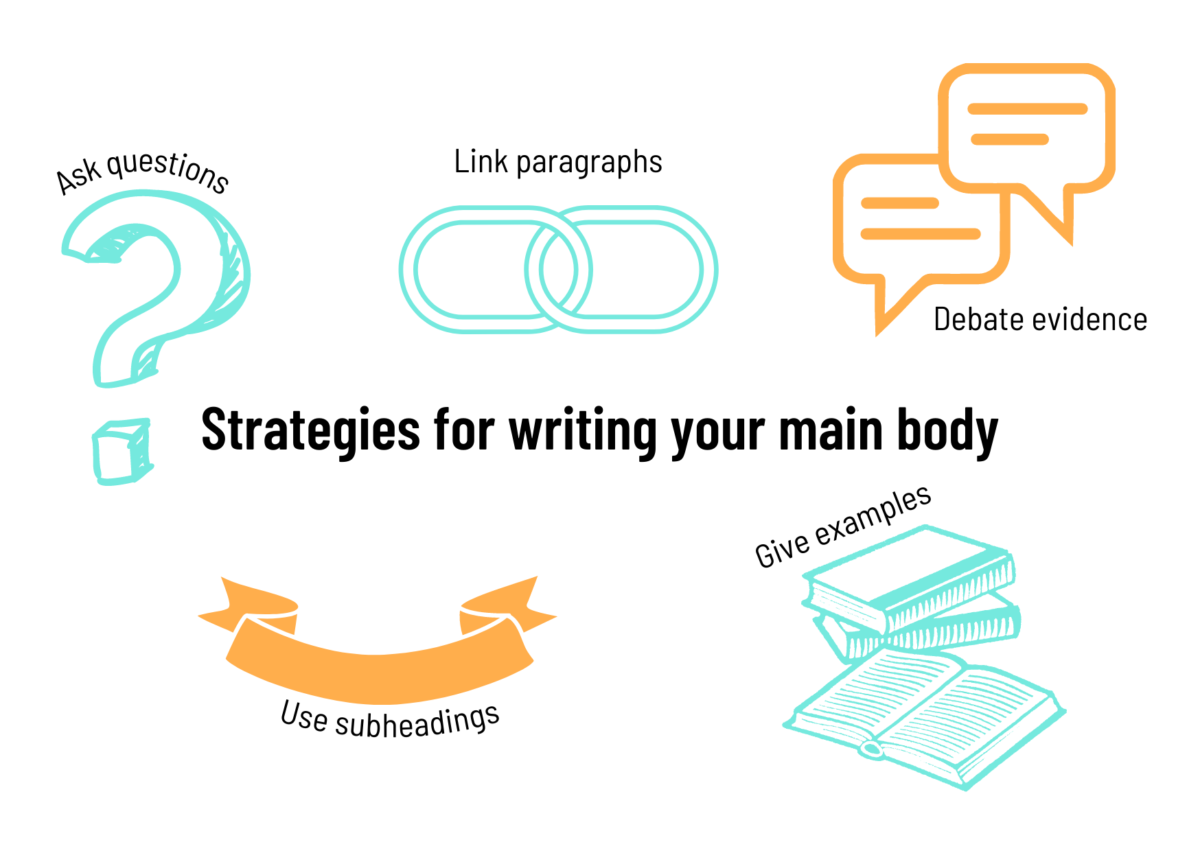- There are different requirements for the main body of your paper depending on the subject you study.
- Elaborate on your topic and illustrate important connections.
- Keep it short, relevant, and critical!
What’s the purpose of the main body of your paper?
The main body part of your paper is where you present your research in depth. It makes up about 80% of your paper and presents a great opportunity to showcase your knowledge. It’s all about elaboration:
- Expand on the topics or areas you mentioned in the introduction.
- Build your argument by writing about and analyzing the evidence you found.
- Structure your argument to guide readers through your argument.
A good main body part achieves three things:
- It not only presents the research at hand, but also situates it within existing research. In other words, it draws connections to other studies by means of comparison.
- It reflects your ability to think critically. So, be critical of existing studies and your own work.
- It relates back to the aim and research questions set in the introduction of your paper.
What belongs in the main body of your academic paper?
Different disciplines follow different standards. For example, you’ll generally find a theory, methodology, and results section in scientific papers, whilst arts and humanities might be open to a looser structure. So, make sure to check what your institution asks for!
Generally, you want to cover the following points in the main body of your assignment:
- Theory: It’s important that you present a sound understanding of existing research and the theoretical frameworks you’re employing in your paper. This doesn’t mean that you should just blindly repeat what others have said before you. Rather, this is a chance to be critical, and point out potential pitfalls or misinterpretations that you hope to illuminate in your paper.
- Methodology: Explain how you are conducting your research. Your findings are only as good as your methods. Again, be critical of the methods you use, and address potential issues.
- Results: This section is where you present your findings. Present them as neutral as possible in scientific papers, and save the interpretation for the following discussion. In arts and humanities subjects, on the other hand, results and discussion often occur simultaneously.
- Discussion: This is arguably the most important part of the main body of an academic paper. It is the culmination of existing and newly found knowledge. It is also the part, in which you may actively present YOUR perspective. This is particularly important in argumentative assignments, in which you are asked to represent a point of view.

How do you write a successful main body for your paper?
There are various ways of writing the main body, but always keep it short, relevant, and critical. The more concise you are, the better!
We’ve collected some strategies for you to help you with your main body:
- Use subheadings and paragraphs: Give your main body structure! The rule here is one idea = one paragraph. This helps you to keep your argument clear and simple.
- Ask questions: You can ask questions such as “Why was this evidence produced? Was it produced to serve a specific purpose?” in your analysis of existing research. This allows you to be critical and reflective.
- Agree or disagree with evidence: Position yourself in the field. Make sure that you explain why you agree or disagree with certain claims.
- Give examples and/or illustrations: Examples help readers understand your argument. Be sure to only include relevant examples that support your perspective.
Pro-tip: Connect your paragraphs to make your argument flow! You can do this by adding or reinforcing an idea, opposing an idea, or relating back to an idea presented earlier.

- Don’t get sidetracked – keep your research questions at the back of your mind!
- Don’t jump around – follow clear logic!
- Don’t be superficial in presenting important information!
Test yourself
State whether the following is true or false: The main body of your paper is solely dedicated to the presentation of your findings.
A. True
B. False
C. Puppies
You’re writing an assignment for your sociology class. You conducted an interview for your study. What should you include in the main body?
A. Theory, methodology, findings, and discussion
B. Theory, methodology, extensive biographies of all the interview participants, findings, discussion
C. A recipe for your favorite chocolate cake
What is a suitable description for the main body of an academic paper?
A. It’s the literal arms and legs of your paper.
B. It’s a quick presentation of everything you learned in class.
C. It’s a founded elaboration on your topic.
How long should the main body of your paper be?
A. About 80%
B. 10 minutes reading time
C. One arm’s length
]What is a strategy you can use to write the main body?
A. Plagiarism
B. Don’t write it at all. Main body sections are overrated anyway.
C. Ask critical questions
Solutions:
B / A / C / A / C

